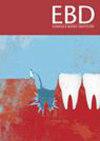Tooth brushing learning methods: time to change practice?
IF 2.3
Q3 Dentistry
引用次数: 0
Abstract
Leghrouz L, Khole M R, Splieth C H, Schmoekel J. Tooth Brushing Learning Methods: Differential or Conventional? – A Randomized Controlled Clinical Trial. Caries Res 2024; 58: 399–406. A two-arm single-blinded randomised controlled clinical trial to investigate the effects of the differential learning method versus conventional tooth brushing instruction by assessing changes in plaque levels and gingivitis in children aged three to eight years. Children aged three to eight years with poor oral hygiene at baseline, needing parental assistance with tooth brushing, and available to attend follow-up appointments were included in the study. Exclusion criteria included children with acute dental pain, those with serious systemic diseases requiring special attention during dental care, and those who refused to participate in the study. Participants were randomly assigned to the test and control groups by self-drawing an unlabelled envelope from a box. The sealed envelopes contained oral hygiene instructions with exercises to use the differential learning method for the test group and children in the control group received the usual tooth brushing instructions. Participants were asked to follow the instructions at home for 28 days. The sample size was calculated according to previous similar oral hygiene studies, with a final sample size of 29 participants in each group to allow for dropouts of approximately 30%. Data was analysed using Microsoft Excel, with the significance threshold set at p < 0.05. Descriptive analysis included the calculation of means, standard deviation, absolute numbers, and percentages. Comparisons between the two groups were made using the independent samples t-test for quantitative variables and the chi-squared test for categorical variables. Two calibrated and blinded examiners recorded the papillary bleeding index (PBI) and the Quigley-Hein Index for dental plaque (QHI) at baseline and at the first and second recall visits at four and twelve weeks respectively. Of the 58 children recruited for the study, 46 were included in the final analysis with 22 in the control group and 24 in the test group. At baseline, there were no significant differences between the groups with respect to plaque and gingival indices. At the first recall, a statistically significant difference in the PBI index was found in favour of the test group (test: 0.1 ± 0.2 v. control: 0.3 ± 0.2; p < 0.001) but the difference in relation to the QHI index was not statistically significant (test: 2.1 ± 0.9 v. control 2.6 ± 0.9; p = 0.07). At the second recall, statistically significant differences in both indices were found in favour of the test group (PBI test: 0.1 ± 0.2 v. PBI control: 0.5 ± 0.2; p < 0.001; QHI test: 2.1 ± 0.9 v. QHI control: 3.2 ± 1; p < 0.001). The authors of the study concluded that simple instructions with the differential learning method for home tooth brushing can lead to significantly greater improvements in oral hygiene in children with poor oral hygiene when compared to traditional instructions, particularly in the medium term retention phase.刷牙学习方法:改时间练?
Leghrouz L, Khole M R, splth C H, Schmoekel J.刷牙学习方法的差异与传统?一项随机对照临床试验。龋齿研究2024;58: 399 - 406。设计:一项双臂单盲随机对照临床试验,通过评估3至8岁儿童牙菌斑水平和牙龈炎的变化,研究差异学习方法与传统刷牙指导的影响。病例选择:研究对象为年龄在3至8岁之间、口腔卫生基线较差、需要父母帮助刷牙、可参加随访预约的儿童。排除标准包括患有急性牙痛的儿童、患有严重全身性疾病需要在牙科护理中特别注意的儿童以及拒绝参加研究的儿童。通过从一个盒子里自己画一个没有标签的信封,参与者被随机分配到试验组和对照组。密封的信封里有口腔卫生说明和练习,实验组的孩子使用不同的学习方法,对照组的孩子则接受常规的刷牙说明。参与者被要求在家中按照指示进行28天。数据分析:样本量是根据之前类似的口腔卫生研究计算的,每组最终样本量为29名参与者,允许大约30%的辍学率。结果:两名校准和盲法检查人员分别在基线和第4周和第12周的第一次和第二次召回访问时记录了牙菌斑的乳头状出血指数(PBI)和Quigley-Hein指数(QHI)。在参与研究的58名儿童中,有46名被纳入最终分析,其中22名在对照组,24名在试验组。在基线时,两组之间在菌斑和牙龈指数方面没有显著差异。在第一次召回时,发现实验组的PBI指数有统计学显著差异(测试:0.1±0.2 v)。对照:0.3±0.2;p结论:该研究的作者得出结论,与传统的口腔卫生指导相比,家庭刷牙的简单指导与差异学习方法可以显著改善口腔卫生,特别是在中期保持阶段。
本文章由计算机程序翻译,如有差异,请以英文原文为准。
求助全文
约1分钟内获得全文
求助全文
来源期刊

Evidence-based dentistry
Dentistry-Dentistry (all)
CiteScore
2.50
自引率
0.00%
发文量
77
期刊介绍:
Evidence-Based Dentistry delivers the best available evidence on the latest developments in oral health. We evaluate the evidence and provide guidance concerning the value of the author''s conclusions. We keep dentistry up to date with new approaches, exploring a wide range of the latest developments through an accessible expert commentary. Original papers and relevant publications are condensed into digestible summaries, drawing attention to the current methods and findings. We are a central resource for the most cutting edge and relevant issues concerning the evidence-based approach in dentistry today. Evidence-Based Dentistry is published by Springer Nature on behalf of the British Dental Association.
 求助内容:
求助内容: 应助结果提醒方式:
应助结果提醒方式:


